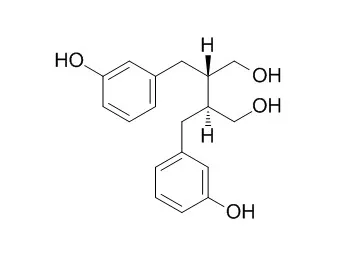| In vitro: |
| International Journal of Angiology, 2000, 9(04):220-225. | | Antioxidant activity of secoisolariciresinol diglucoside-derived metabolites, secoisolariciresinol, Enterodiol, and enterolactone.[Reference: WebLink] |
METHODS AND RESULTS:
Secoisolariciresinol diglucoside (SDG), an antioxidant isolated from flaxseed, is metabolized to secoisolariciresinol (SECO), Enterodiol (ED), and enterolactone (EL) in the body.
The effectiveness of SDG in hypercholesterolemic atherosclerosis, diabetes, and endotoxic shock could be due to these metabolites. These metabolites may have antioxidant activity. However, the antioxidant activity of these metabolites is not known. The antioxidant activity of SECO, ED, and EL was investigated using chemiluminescence (CL) of zymosan-activated polymorphonuclear leukocytes (PMNLs) [PMNL-CL]. Other antioxidants (SDG and vitamin E) were also used for comparison. SDG, SECO, ED, EL, and vitamin E, each in the concentration of 0.5, 1.0, 2.5, 5.0 and 10.0 mg/ml, produced a concentration-dependent reduction in zymosan-activated PMNL-CL. SDG, SECO, ED, EL, and vitamin E, in the concentration of 2.5 mg/ml, produced a reduction of zymosan-activated PMNL-CL by 23.8%, 91.2%, 94.2%, 81.6% and 18.7%, respectively. Activated PMNLs produce reactive oxygen species and luminol-dependent CL reflects the amount of oxygen species generated from activated PMNLs. The reduction of PMNL-CL, therefore, reflects the antioxidant activity of the compounds studied.
CONCLUSIONS:
These results suggest that the metabolites of SDG have antioxidant activity. The antioxidant activity was highest with SECO and ED and lowest with vitamin E. The antioxidant potency of SECO, ED, EL, and SDG was 4.86, 5.02, 4.35, and 1.27 respectively, as compared to vitamin E. SECO, ED and EL are respectively 3.82, 3.95, and 3.43 more potent than SDG. | | Journal of the Science of Food & Agriculture,2019,99(4):2411-2419. | | Apoptotic effect of enterodiol, the final metabolite of edible lignans, in colorectal cancer cells.[Reference: WebLink] | Enterodiol (END) is transformed by human intestinal bacteria from lignans contained in various whole‐grain cereals, nuts, legumes, flaxseed, and vegetables. It is known to have several physiological effects, but its effects on mitogen‐activated protein kinase (MAPK) signaling and apoptosis in colorectal cancer (CRC) cells have not yet been elucidated.
METHODS AND RESULTS:
We therefore investigated the effects of END on apoptosis in CRC cells and whether these effects are mediated via MAPK signaling. Cell proliferation was decreased by END treatment in a time‐dependent manner. In particular, END treatment resulted in an apoptosis rate of up to 40% in CT26 cells but showed no cytotoxicity toward RAW264.7 macrophages. Treatment with END also suppressed the migration of CRC cells in a concentration‐dependent manner. The phosphorylation of extracellular signal‐regulated kinase (ERK), jun N‐terminal kinase (JNK), and p38 was down‐regulated with END treatment. Furthermore, END decreased the expression levels of anti‐apoptotic proteins in CRC cells. Enterodiol inhibited the growth of CRC cells by controlling the MAPK signaling pathway involved in proliferation and apoptosis.
CONCLUSIONS:
These results demonstrate that END has an apoptotic effect in CRC cells. |
|






 Cell. 2018 Jan 11;172(1-2):249-261.e12. doi: 10.1016/j.cell.2017.12.019.IF=36.216(2019)
Cell. 2018 Jan 11;172(1-2):249-261.e12. doi: 10.1016/j.cell.2017.12.019.IF=36.216(2019) Cell Metab. 2020 Mar 3;31(3):534-548.e5. doi: 10.1016/j.cmet.2020.01.002.IF=22.415(2019)
Cell Metab. 2020 Mar 3;31(3):534-548.e5. doi: 10.1016/j.cmet.2020.01.002.IF=22.415(2019) Mol Cell. 2017 Nov 16;68(4):673-685.e6. doi: 10.1016/j.molcel.2017.10.022.IF=14.548(2019)
Mol Cell. 2017 Nov 16;68(4):673-685.e6. doi: 10.1016/j.molcel.2017.10.022.IF=14.548(2019)